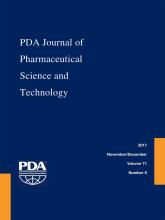Abstract
USP <1207.1> Section 3.5 states that “A deterministic leak test method having the ability to detect leaks at the product's maximum allowable leakage limit is preferred when establishing the inherent integrity of a container-closure system.” Ideally, container closure integrity of parenteral packaging would be evaluated by measuring a physical property that is sensitive to the presence of any package defect that breaches package integrity by increasing its leakage above its maximum allowable leakage limit. The primary goals of the work presented herein were to demonstrate the viability of the nondestructive, deterministic method known as laser-based gas headspace analysis for evaluating container closure integrity and to provide a physical model for predicting leak rates for a variety of container volumes, headspace conditions, and defect sizes. The results demonstrate that laser-based headspace analysis provides sensitive, accurate, and reproducible measurements of the gas ingress into glass vial-stopper package assemblies that are under either diffusive or effusive leak conditions. Two different types of positive controls were examined. First, laser-drilled micro-holes in thin metal disks that were crimped on top of 15R glass vials served as positive controls with a well-characterized defect geometry. For these, a strong correlation was observed between the measured ingress parameter and the size of the defect for both diffusive and effusive conditions. Second, laser-drilled holes in the wall of glass vials served as controls that more closely simulate real-world defects. Due to their complex defect geometries, their diffusive and effusive ingress parameters did not necessarily correlate; this is an important observation that has significant implications for standardizing the characterization of container defects. Regardless, laser-based headspace analysis could readily differentiate positive and negative controls for all leak conditions, and the results provide a guide for method development of container closure integrity tests.
LAY ABSTRACT: The new USP 39 <1207>, “Package Integrity Evaluation—Sterile Products”, states in section 3.4.1: “tracer gas tests performed using … laser-based gas headspace analysis [have] been shown to be sensitive enough to quantitatively analyze leakage through the smallest leak paths found to pose the smallest chance of liquid leakage or microbial ingress in rigid packaging.” In addition, USP <1207> also states that “for such methods, the limit of detection can be mathematically predicted on the basis of gas flow kinetics.” Using the above statements as a foundation, this paper presents a theoretical basis for predicting the gas ingress through well-defined defects in product vials sealed under a variety of headspace conditions. These calculated predictions were experimentally validated by comparing them to measurements of changes in the headspace oxygen content or total pressure for several different positive controls using laser-based headspace analysis. The results demonstrated that laser-based headspace analysis can, by readily differentiating between negative controls and positive controls with a range of defect sizes on the micron scale, be used to assess container closure integrity. The work also demontrated that caution must be used when attempting to correlate a leak rate to an idealized defect-size parameter.
- Container closure integrity
- USP 39 Chapter <1207>
- USP 1207
- Sterility
- Gas leak rate
- Gas ingress
- Headspace analysis
- Frequency modulation spectroscopy
- © PDA, Inc. 2017
PDA members receive access to all articles published in the current year and previous volume year. Institutional subscribers received access to all content. Log in below to receive access to this article if you are either of these.
If you are neither or you are a PDA member trying to access an article outside of your membership license, then you must purchase access to this article (below). If you do not have a username or password for JPST, you will be required to create an account prior to purchasing.
Full issue PDFs are for PDA members only.
Note to pda.org users
The PDA and PDA bookstore websites (www.pda.org and www.pda.org/bookstore) are separate websites from the PDA JPST website. When you first join PDA, your initial UserID and Password are sent to HighWirePress to create your PDA JPST account. Subsequent UserrID and Password changes required at the PDA websites will not pass on to PDA JPST and vice versa. If you forget your PDA JPST UserID and/or Password, you can request help to retrieve UserID and reset Password below.






